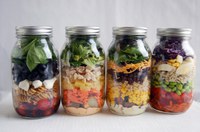Prairie Fare: 6 Steps to Making a Salad in a Jar
(Click an image below to view a high-resolution image that can be downloaded)
By Julie Garden-Robinson, Food and Nutrition Specialist
NDSU Extension Service
Every now and then I get a little envious of the creativity of my co-workers’ lunches.
I have noted a couple of people making “salads in a jar” on occasion. All they need to do is gently shake the glass quart jar to mix the ingredients, grab a fork and enjoy their healthful creation.
Maybe these lunches were inspired by colorful photos shared on Facebook or Pinterest or another social media outlet. In this week’s column, I was inspired by the work of my dietetic intern and a staff member who made salads in a jar when I was at a conference.
However, seeing the photos is not quite the same as tasting the recipes, but I was assured the salads were tasty.
Most people shortchange themselves on fruits and vegetables, so filling a quart jar with a variety of veggies, fruits, protein and grains provides a balanced meal. On average, adults need at least 4 1/2 cups of fruits and vegetables daily. In 2017, the Centers for Disease Control and Prevention reported that just one in 10 people meets the goal.
If you are trying to consume more vegetables or fruits, tap into your creative side and personalize your creation. If you have children or grandchildren, invite them into the kitchen to help prepare these no-fuss salads. All you do is add the salad dressing of your choice and then layer the ingredients. Shake together when ready to eat.
Start with safety. Thoroughly rinse vegetables and fruit before cutting and adding to your salad. Water speeds spoilage/wilting of salads, so spin lettuce and vegetables in a salad spinner or pat dry with paper toweling. Store salad in a refrigerator at 40 F, and for best quality and safety, use your salads within four days of preparation.
Here’s how to make a salad in a glass quart-size jar:
Step 1: Add 1 to 2 tablespoons of your dressing of choice to the jar. Nutritional value varies among salad dressing types, so consult the information on the label. Salad dressings add flavor to your salad, so don’t be afraid to expand your horizons and try something new. Placing the salad dressing in the jar first helps prevent the salad from wilting. If desired, you can keep the dressing separate and add it right before eating.
Consider making your own salad dressing to avoid excess sodium while adding a personalized flavor. See the NDSU Extension publication “7 Tips for Choosing and Using Healthful Oils and Fats” (https://tinyurl.com/HealthfulOils) to learn about creating a salad dressing.
Step 2: Choose one or a variety of vegetables. Add 1/2 cup of chopped vegetables for texture, flavor and nutrition. Consider enhancing the flavor by roasting vegetables drizzled in olive oil with desired seasonings in a 400 F oven until they reach your desired tenderness. Most take 30 to 40 minutes to roast and should be stirred every 15 minutes. Cool, then add to your salad.
Consider using leftover cooked potatoes, squash or sweet potatoes, or begin with fresh, raw chopped or sliced vegetables when creating your salad. Here are some options, with the approximate calorie content per half cup indicated in parentheses: sliced beets (35), bell peppers (74), broccoli (15), carrots (26), cauliflower (14), celery (8), corn (60), edamame (soy beans) (64), green beans (13), mushrooms (8), potatoes (58), radishes (10), squash (15), sweet potatoes (57), tomatoes (16) or zucchini (10).
Step 3: Choose one or more fruits if desired. Add 1/2 cup of fruit to contribute fiber and a touch of sweetness. Examples of fruit (with approximate calorie content shown in parentheses) include apple slices dipped in lemon juice or an anti-darkening solution (such as Fruit Fresh) to prevent browning (32), blueberries (42), grapefruit chunks (44), grapes (33), mango slices (50), orange slices (42), raspberries (32) or strawberries (27).
Step 4: Choose one grain if desired. Adding 1/2 cup of cooked, chilled grain of your choice balances the flavor of the ingredients. Examples (with approximate calorie content in parentheses) include brown rice (120), couscous (88), pasta (110), whole wheat (72) or quinoa (111). Adding quinoa to your salad creation increases the fiber and protein content for an extra-satisfying salad.
Step 5: Choose one or more proteins. Add 1/2 cup of protein to your salad. Examples (with approximate calorie content shown in parentheses) include drained and rinsed canned black beans (110), kidney beans (95), pinto beans (99), chicken (115), chickpeas (105), hard-cooked egg (105), cooked lentils (115), shrimp (48), medium-well done steak slices (142), tofu (36) or turkey (65). Draining and rinsing canned beans washes away up to 40 percent of the sodium. Be sure to use lean meats and trim away extra fat for optimal nutrition; cook meat to a safe internal cooking temperature.
Step 6: Choose one or more toppings. Toppings enhance flavor and add interest and nutrition to your salad creation. Add about 1 tablespoon of each desired topping. Approximate calorie content per tablespoon is shown in parentheses: blue cheese (30); croutons (8); dried cranberries (23); feta cheese (25); nuts such as almonds (33), pecans (48) or walnuts (48); olives (10); raisins (33); shredded cheese (29); or sunflower seeds (52).
Enjoy your creation and add up the calories if you’d like.
If you prefer a recipe, here’s an example of a layered salad you can make with planned-over foods. You might even be inspired to grow some vegetables this summer. Check out the NDSU Extension Field to Fork website at https://www.ag.ndsu.edu/fieldtofork to view online webinars about growing foods in our region, along with many garden-to-table nutrition-related handouts and recipes.
Barbecue Chicken and Ranch Layered Salad in a Jar
2 Tbsp. barbecue ranch dressing
1/4 c. roasted potatoes with parsley
1/4 c. carrots, shredded
1/2 c. pineapple, fresh or canned
1/2 c. grilled chicken, chopped
1 c. romaine lettuce, rinsed and patted dry
Prepare ingredients as directed. Layer in order in a glass jar. Cover and refrigerate up to four days.
Makes one serving, with 310 calories, 11 grams (g) fat, 24 g protein, 29 g carbohydrate, 3 g fiber and 190 milligrams sodium.
(Julie Garden-Robinson, Ph.D., R.D., L.R.D., is a North Dakota State University Extension Service food and nutrition specialist and professor in the Department of Health, Nutrition and Exercise Sciences. Follow her on Twitter @jgardenrobinson)
NDSU Agriculture Communication - April 19, 2018
| Source: | Julie Garden-Robinson, 701-231-7187, julie.garden-robinson@ndsu.edu |
|---|---|
| Editor: | Ellen Crawford, 701-231-5391, ellen.crawford@ndsu.edu |



